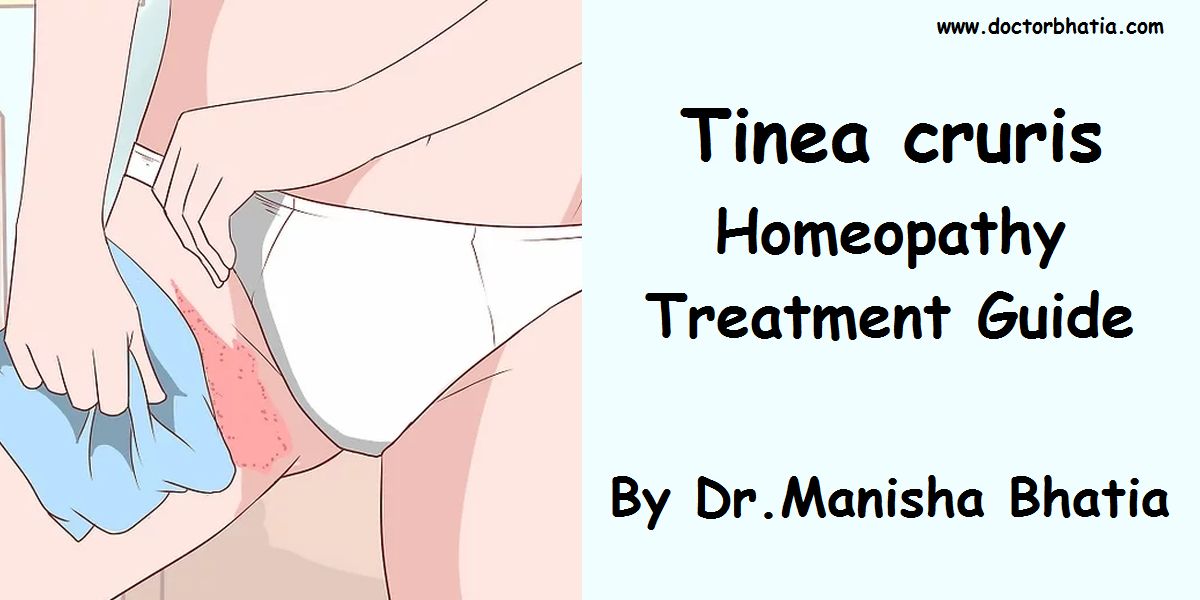Tinea cruris is the scientific name for fungal infection of the groin region. Official alternative names include jock itch.
Symptoms and signs of Tinea cruris
As the common name for this condition implies, it causes itching or a burning sensation in the groin area, thigh skin folds, or anus. It may involve the inner thighs and genital areas, as well as extending back to the perineum and perianal areas.
Affected areas may appear red, tan, or brown, with flaking, rippling, peeling, or cracking skin.[1][2]
The acute infection begins with an area in the groin fold about a half-inch across, usually on both sides. The area may enlarge, and other sores may develop in no particular pattern. The rash appears as raised red plaques (platelike areas) and scaly patches with sharply defined borders that may blister and ooze.[3]
If the rash advances, it usually advances down the inner thigh. The advancing edge is redder and more raised than areas that have been infected longer. The advancing edge is usually scaly, and very easily distinguished or well demarcated.
The skin within the border turns a reddish-brown and loses much of its scale. The border may exhibit tiny pimples or even pustules, with central areas that are reddish and dry with small scales.[4][5]
If infected with candidal organisms, the rash tends to be redder and wetter. The skin of the penis may be involved, whereas other organisms spare the penis.
Causes of Tinea cruris
Opportunistic infections (infections that are caused by a diminished immune system) are frequent. Fungus from other parts of the body (commonly tinea pedis or ‘athlete’s foot’) can contribute to jock itch. A warm, damp environment allowing the fungus to cultivate greatly contributes; especially with tight, sweaty or rubbing clothing such as a jockstrap.
The type of fungus that most commonly causes tinea cruris is called Trichophyton rubrum. Some other contributing fungi are Candida albicans, Trichophyton mentagrophytes and Epidermophyton floccosum.
Treatment of Tinea cruris
Tinea cruris is best treated with antifungal drugs applied topically. Traditionally creams containing tolnaftate, clotrimazole or miconazole have been used, although newer agents such as butenafine are also used. These anti-fungal agents work by stopping the fungi from producing a substance called ergosterol, which is an essential component of fungal cell membranes. If ergosterol synthesis is completely or partially inhibited, the cell is no longer able to construct an intact cell membrane. This leads to death of the fungus.
If the skin inflammation causes discomfort and itching, glucocorticoid steroids may be combined with the anti-fungal drug to help prevent further irritation due to the patient scratching the area. Apart from the quicker relief of symptoms, this also helps minimise the risk of secondary bacterial infection caused by the scratching. However, steroids may exacerbate the condition if used alone for fungal infections.
To cure the infection naturally, keep moist and warm areas of the body clean and dry. Change anything the fungus comes into contact with daily, like undergarments and towels. You can use talcum powder to help keep the area dry. Powders with menthol or zinc oxide may be used, like Gold Bond medicated powder, to soothe the itch. Avoid the transmission of the fungus to other parts of the body when drying. You can use anti-dandruff shampoos on the infected skin as many contain anti-fungal chemical compounds such as pyrithione zinc, selenium sulfide, and ketoconazole (Nizoral). Tea tree oil can also be used since it is a natural anti-fungal.[1] Garlic is also known to have anti-fungal properties because it contains allicin.
Homeopathy Treatment for Tinea cruris
Keywords: homeopathy, homeopathic, treatment, cure, remedy, remedies, medicine
Homeopathy treats the person as a whole. It means that homeopathic treatment focuses on the patient as a person, as well as his pathological condition. The homeopathic medicines are selected after a full individualizing examination and case-analysis, which includes the medical history of the patient, physical and mental constitution, family history, presenting symptoms, underlying pathology, possible causative factors etc. A miasmatic tendency (predisposition/susceptibility) is also often taken into account for the treatment of chronic conditions. A homeopathy doctor tries to treat more than just the presenting symptoms. The focus is usually on what caused the disease condition? Why ‘this patient’ is sick ‘this way’. The disease diagnosis is important but in homeopathy, the cause of disease is not just probed to the level of bacteria and viruses. Other factors like mental, emotional and physical stress that could predispose a person to illness are also looked for. No a days, even modern medicine also considers a large number of diseases as psychosomatic. The correct homeopathy remedy tries to correct this disease predisposition. The focus is not on curing the disease but to cure the person who is sick, to restore the health. If a disease pathology is not very advanced, homeopathy remedies do give a hope for cure but even in incurable cases, the quality of life can be greatly improved with homeopathic medicines.
The homeopathic remedies (medicines) given below indicate the therapeutic affinity but this is not a complete and definite guide to the homeopathy treatment of this condition. The symptoms listed against each homeopathic remedy may not be directly related to this disease because in homeopathy general symptoms and constitutional indications are also taken into account for selecting a remedy. To study any of the following remedies in more detail, please visit the Materia Medica section at Hpathy.
None of these medicines should be taken without professional advice and guidance.
Homeopathy Remedies for Tinea cruris :
Ail., arg-n., calc., carb-an., carb-s., carb-v., chin., cina., cupr., cupr-ac., cur., fil., form., frag-v., gran., graph., grat., kali-c., kali-i., mag-m., merc., nat-c., nat-s., nux-v., petr., phos., plat., puls., sabad., sant., sep., sil., stann., sulph., ter., thuj., valer.
References
- ^ Shemesh, A., and W. L. Mayo. 1991. “Australian tea tree oil: a natural antiseptic and fungicidal agent.” Aust. J. Pharm. 72:802-803


